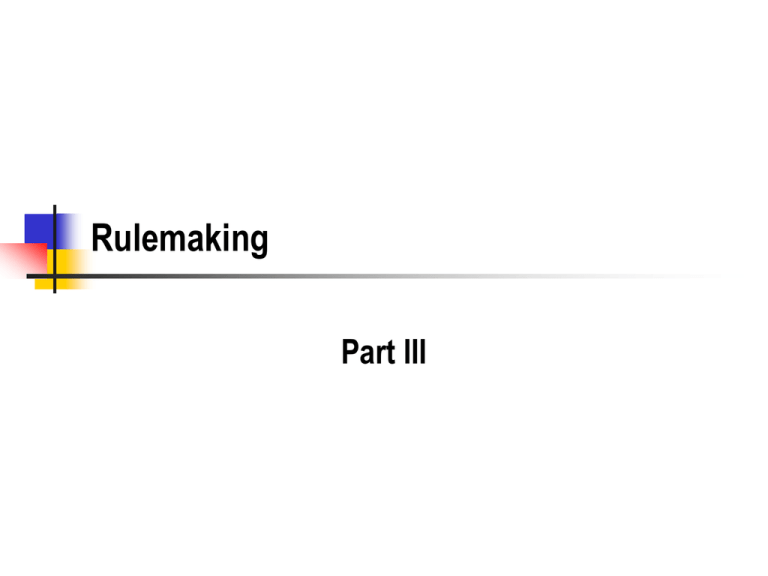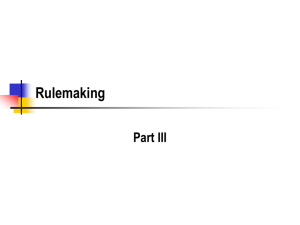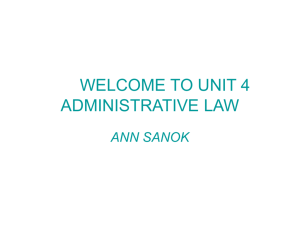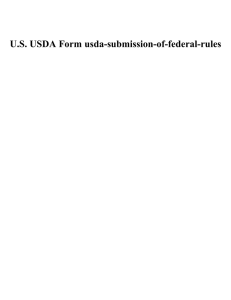Rulemaking Part III
advertisement

Rulemaking Part III When is Formal Rulemaking Required? Grew out of ratemaking Just like formal adjudications Very time consuming and expensive Courts try to avoid making agencies do it Must have magic language Only when rules are required by statute to be made on the record after opportunity for an agency hearing 2 Why avoid formal rulemaking? The peanut hearings Should peanut butter have 87 or 90% peanuts? 10 years and 7,736 pages of transcript What was the concern in Shell Oil v. FPC? Formal rulemaking was impossibly time consuming to use for regulating something changeable such as natural gas rates. Why does just getting the right to be heard at a formal hearing benefit parties that oppose a rule? 3 The Procedures of Notice-and-Comment Rulemaking Putting the Notice in Notice and Comment 553(b) . . . The notice shall include — (1) a statement of the time, place, and nature of public rulemaking proceedings; (2) reference to the legal authority under which the rule is proposed; and (3) either the terms or substance of the proposed rule or a description of the subjects and issues involved. . . . 5 Notice of the Proposed Rule Chocolate Manufacturers Ass’n v. Block What did Congress tell the agency to do that resulted in these regs? What did the proposed rule address? What about fruit juice? How was the final rule different from the proposed rule? 6 The Notice Problem What was the CMA's claim? What was the agency defense? Does the rule have to be the same? Why have notice and comment then? What is the logical outgrowth test? How would you use it in this case? What did the court order in this case? What will the CMA do? 7 8 9 What about Technical Information Underlying the Rule? Portland Cement v. Ruckelshaus, 486 F2d 375 (1973) The agency must disclose the factual basis for the proposed rule, if it relied on scientific studies or other collections of information Connecticut Light and Power v. NRC, 673 F2d 525 (1982)? The agency cannot play hide the peanut with technical information Why is this a big deal in environmental regs? What are the potential downsides of this policy? 10 Shelby Amendments to the Freedom of Information Act As we will learn later, the FOIA traditionally applied only to information in possession of government agencies Senator Shelby, at the urging of several business lobbies, successfully extended FOIA to information produced by federally funded research and in the hands of universities Why would business lobbies want access to this information, esp. in environmental rulemakings? Why might such access be a problem for professors? 11 Health Insurance Portability and Accountability Act of 1996 Congress directed HHS to promulgate privacy rules on electronically transmitted medical records Why is this a special problem? Proposed rule covered electronically transmitted records Final rule covers all records, if any are electronically transmitted. Is this a notice problem? 12 Additions to the Published Record Rybachek v EPA EPA added 6000 pages of supporting info Court said the agency may supplement the rulemaking record in response to comments asking for explanation Idaho Farm Agency added a report to the record, then relied on it in the final rule. The agency may not add new material and then rely on it without given an opportunity to 13 comment on it. Negotiated Rulemaking What is this? What are the advantages? What are the public participation issues? 14 Ex Parte Communications Adjudications and Article III Trials Why do we care about ex parte communications in trials? How is this different in adjudications? How does separation of functions reduce the problem of ex parte communications in adjudications? 16 Rulemaking How does the notice provision in rulemaking change the issues in ex parte communications? How does the notice requirement eliminate the ex parte communications issues for communications before the promulgation of the rule? When are ex parte communications an issue? How can you cure this? 17 Home Box Office, Inc. v. FCC What was being regulated? Who were the contacts with? What did the court say should be avoided? If it is not avoided, what needs to be done? 18 Sierra Club v. Costle Sierra Club claimed Senator Bird coerced the EPA on coal burning power plant standards Why would Senator Bird care about this? How could Senator Bird put pressure on the agency? 19 Volpe Test The Volpe test for whether a rulemaking may be overturned solely on evidence of Congressional pressure 1) was there specific pressure on the agency to consider improper factors? 2) did the agency in fact change its mind because of these considerations? How can the agency defend itself from a Volpe attack? What did the Court Rule when it applied Volpe to this Case? Why is it proper for congressmen to comment on proposed rules? 20 What is the president's role in rulemaking? Controls and supervises executive branch decisionmaking How is the role different in adjudications? When should the president's contacts be documented? When the statute requires that they be docketed If the rule is based on factual information that comes from such a meeting. 21 Bias and Prejudice Remember the cases on bias of decisionmakers in adjudications? Should these also apply to rulemaking? How does notice and comment change the situation? 22 Association of National Advertisers , Inc. v. FTC FTC is adopting rules on TV advertising directed at children Chairman has written and spoken at length on the evils of TV ads aimed at children Plaintiffs seek to disqualify him because of bias What happened in Cinderella? Cinderella disqualified the same Chairman from participating in an adjudication because he had prejudged some of the facts. 23 Is the Standard Different for Rulemaking? Clear and convincing evidence that he has an unalterably closed mind on matters critical to the rulemaking 24 How are state agencies different from federal agencies? Limited staff Greater reliance on the expertise of board members, rather than staff Board may hear lots of testimony and review a lot of info - they cannot afford the time and effort to put together volumes of supporting info for regs Should state agencies have a reduced publication requirement? Should they be able to publish rules without explanation and only have to explain if asked? 25 Hybrid Rulemaking (Congressional Mandates) at the FTC issue an advance notice of proposed rulemaking, which describes the area of inquiry under consideration and invites comments from interested parties; send the advance notice and, 30 days before its publication, the notice of proposed rulemaking to certain House and Senate committees; hold a hearing presided over by a hearing officer at which persons may make oral presentations and in certain circumstances to conduct cross-examination of persons; include a statement of basis and purpose to address certain specified concerns; and conduct a regulatory analysis of both the proposed and final rules that describes the proposal and alternatives that would achieve the same goal and analyzes the costs and benefits of the 26 proposal and the alternatives. Executive Orders Regulating Rulemaking What is the president's authority over rulemaking? What about for independent agencies? Why should the president exercises authority over rulemaking? Coordination of agencies? Assuring that the agencies carry out the administration's objectives? 27 Regulatory Analysis What is CBA? Why is CBA sometimes very controversial, especially for environmental regulations? What is the value of regulatory analysis? What is PBA? (political benefit analysis) Why does it always trump CBA? 28 Cost-benefit and Risk-benefit analysis Justice Breyer's tunnel vision problem Each rule is seen without reference to all the other regulations Why is this a problem in environmental law? The cost of removing the last 5% of crap What about asbestos and brown fields? Why does HHS and the state continue to favor high tech medicine over primary care? What is the CBA? 29 What are areas where CBA can have adverse effects? Do the costs and benefits always fall on the same group? How does the diffuse and long term nature of benefits complicate CBA? Should we use CBA for health regulations? 30 Acronyms OMB - Office of Management and Budget OIRA - Office of Information and Regulatory Affairs 31 Executive Order 12866 OIRA must review rules that have an impact of more than 100M aggregate or substantial impact on a segment of the economy or any thing else. 32 The Regulatory Philosophy Federal agencies should promulgate only such regulations as are required by law, are necessary to interpret the law, or are made necessary by compelling public need, such as material failures of private markets to protect or improve the health and safety of the public, the environment, or the well-being of the American people. In deciding whether and how to regulate, agencies should assess all costs and benefits of available regulatory alternatives, including the alternative of not regulating. 33 CBA under 12866 Costs and benefits shall be understood to include both quantifiable measures (to the fullest extent that these can be usefully estimated) and qualitative measures of costs and benefits that are difficult to quantify, but nevertheless essential to consider. 34 Choosing Among Alternatives Further, in choosing among alternative regulatory approaches, agencies should select those approaches that maximize net benefits (including potential economic, environmental, public health and safety, and other advantages; distributive impacts; and equity), unless a statute requires another regulatory approach. Pretty simple? :-) 35 What must the agency provide OIRA - I An assessment, including the underlying analysis, of benefits anticipated from the regulatory action (such as, but not limited to, the promotion of the efficient functioning of the economy and private markets, the enhancement of health and safety, the protection of the natural environment, and the elimination or reduction of discrimination or bias) together with, to the extent feasible, a quantification of those benefits; 36 What must the agency provide OIRA - II An assessment, including the underlying analysis, of costs anticipated from the regulatory action (such as, but not limited to, the direct cost both to the government in administering the regulation and to businesses and others in complying with the regulation, and any adverse effects on the efficient functioning of the economy, private markets (including productivity, employment, and competitiveness), health, safety, and the natural environment), together with, to the extent feasible, a quantification of those costs; 37 What must the agency provide OIRA - III An assessment, including the underlying analysis, of costs and benefits of potentially effective and reasonably feasible alternatives to the planned regulation, identified by the agencies or the public (including improving the current regulation and reasonably viable nonregulatory actions), and an explanation why the planned regulatory action is preferable to the identified potential alternatives. 38 What are the potential effects on agencies of these mandates? Does this undermine the intent of their enabling laws? How can the president do this without legislation? 39 12866 and Rulemaking What if the statute says no CBA - can the president impose it anyway? Why is there a special provision for analyzing impact on small businesses? 40 Unfunded Mandates What is an unfunded mandate? How is this stealth regulatory reform? Unfunded Mandates Act of 1995 - Agency must do a CBA if the costs exceed 100M What would be the impact of banning unfunded mandates? What are the types and impact of unfunded mandates on public schools? Oregon's answer in land use 41

![Minnesota Department of [Name] MEMORANDUM](http://s2.studylib.net/store/data/015049440_1-475d22d0ab7bd661c71329dec0ae8429-300x300.png)




